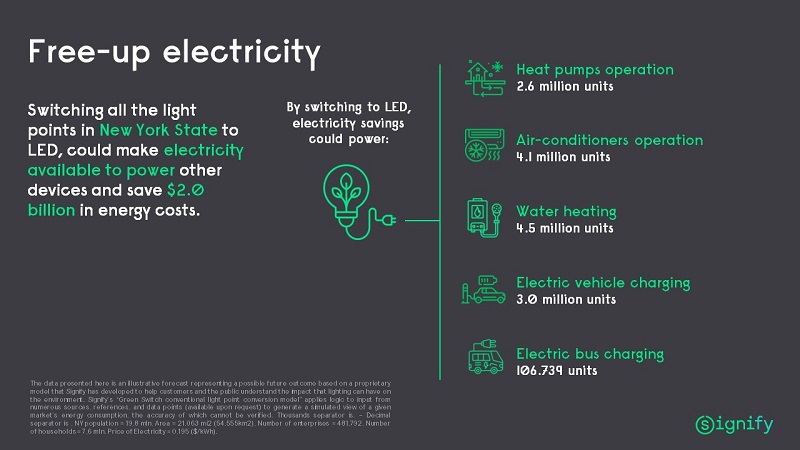By Harry Verhaar, Head of Global Public & Government Affairs, Signify
Opportunity and action are on the agenda at Climate Week.
Climate Week NYC kicked off on September 16, 2023, with an important theme: “We Can. We Will.” Leading politicians, businesses, and investors are in attendance.
For several years, scientists, associations, and business have been stating that the technologies to bend the curve on global emissions and global warming are available. This year’s weather anomalies have shown more clearly than ever before that “We Can. We Will.” is a moral imperative that has never been more urgent to follow up on than it is now.
While greenhouse gas reduction targets and regulatory frameworks are set at global and national levels, the transition to green energy and a green economy can take root at the state and municipal levels. But we need to focus on solutions and actions rather than problems and complexities.
With the Inflation Reduction Act (IRA) and the Infrastructure Investment and Jobs Act (IIJA) in the United States, the EU Green Deal, and other such initiatives around the world, there is currently a lot of focus on the supply side of the energy transition. There’s a focus on identifying alternative gas sources, scaling up renewables, and using nuclear and hydrogen as energy sources (though these will take longer to become viable).
Complementary measures on the demand side offer an important opportunity for significant and quick reductions of emissions and costs, through both active and passive energy efficiency technologies and solutions. Energy efficiency may seem like an invisible form of energy, but in reality it drives economic growth and the green economy. It creates local jobs for implementing passive efficiency measures (installing insulation and double- or triple-glazing windows) and active efficiency measures (installing building management systems and changing the lights in the ceilings and streets). These measures will drive growth and provide many blue collar jobs into the future, while lowering energy bills and improving comfort and safety.
“The solutions to the current crisis are well-known and need to be rapidly scaled up. Clean electricity will be the backbone of the net-zero economy, enabling us to electrify almost everything which currently emits carbon,” explains Alice Steenland, Chief Strategy and Sustainability Officer at Signify. “This combined with energy-saving technologies will mean we can go much further and faster than we are today. These developments will have multiple co-benefits, from cleaner air to improved living and workspaces.”
Energy-efficient lighting is one area in which states and cities can take quick action to reduce both emissions and costs. This could include switching to LED and connected LED lighting in city streets, offices, factories, or other commercial and municipal buildings.
Approximately half of the world’s light points are still conventional. This shows that there is a significant potential for an LED transition in the coming years. Interestingly, states and cities would not only reduce their emissions and energy bills, but, as the World Council on City Data showed some years ago, LED implementation can also reduce nighttime traffic incidents by around 30 percent, and street crime by around 20 percent.
In the United States, smart LED lighting can contribute an annual reduction in emissions of 70 million tons of CO2 and save $28 billion in energy costs. Those savings bring the potential to add capacity in energy networks for other purposes – most importantly, the electrification of transportation and heating. The global average electricity consumption for a household is approximately 3,500 kW/h per year – roughly the same amount of electricity it would take to charge an electric vehicle to travel 10,000 miles in the course of a year.
By transitioning to LED lighting at scale, the United States can save enough energy to power almost 42 million heat pumps or charge 49 million electric vehicles per year. If we take New York State as an example of the effect at the state level, the numbers are equally significant and relevant. For example, a statewide switch to connected LED lighting offers the potential to free up enough electricity to operate 2.6 million heat pumps or charge 3 million electric vehicles per year.
“The impact that energy efficiency has made and can make toward climate mitigation is often overlooked and understated,” explains Paula Glover, President of the Alliance to Save Energy. “Were it not for the energy efficiency investments made since 1980, annual emissions would be nearly 80 percent higher than what they are currently. Additionally, the IEA estimates that energy efficiency alone can deliver 40 percent of the emission reductions required by the Paris Agreement.”
But there’s more, says Glover: “The value of energy efficiency goes far beyond reducing carbon emissions – and includes billions of dollars in energy cost savings annually, in addition to adding greater reliability to U.S. energy systems. As we invest in climate strategies that lead with energy efficiency first, we better define future capacity and supply needs, positively impact utility rates, lower energy costs behind the meter, drive emissions downward, and lay the foundation for a just energy transition.”
A cohesive energy transition plan built in this way can tap into the potential of energy efficiency. Renewables and energy efficiency combined can create a transition to a decarbonized society that is twice as fast and twice as cheap, because the clean energy being generated is not being wasted in offsetting fossil fuels. Instead, it is going much further in powering more efficient homes and buildings.
There is more positive news. The IRA, signed into law in 2022, is one of the most significant pieces of climate legislation in history. Multibillion dollar investments are available for clean technologies. “The Inflation Reduction Act and the bipartisan Infrastructure Investment and Jobs Act provided a monumental boost to energy efficiency funding,” said Lisa Jacobson, President of the Business Council for Sustainable Energy. “Notably, the pair of legislation provided $3.5 billion to weatherize homes in underserved communities and $8.8 billion for home energy efficiency rebates, among other energy efficiency incentives. These incentives are crucial for driving down energy costs for consumers, reducing U.S. carbon emissions, and building resilient electrical grids.”
As delegates convene in New York for this year’s week of climate deliberations, they need to keep this year’s theme of “We Can. We Will.” at the top of their minds. We need the world’s largest economy to accelerate rapid and positive change and not only unlock the potential of energy efficiency but also decisively turn climate action into a race for the net-zero future that we need today and that future generations deserve.
About the author: Harry Verhaar is Head of Public & Government Affairs at Signify. Signify is a world leader in energy-efficient lighting products, services, and systems, with the ultimate goal of making the world a more productive and livable place.


